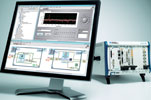

National Instruments has released LabVIEW 8.5, the latest version of the graphical system design platform for test, control and embedded system development.
Using LabVIEW 8.5 to program multicore systems, test engineers can now design new production testers with increased test throughput by performing parallel operations such as data acquisition, generation and analysis on multiple processor cores. With the inherent parallelism of the LabVIEW dataflow language and built-in multithreading, engineers can build advanced systems that balance the workload among available processing cores. Because of the simplified graphical approach to multithreading in LabVIEW, engineers already using LabVIEW can also take advantage of multicore technology to achieve performance gains for their existing test systems with little to no change to their applications.
LabVIEW 8.5 running on multicore processors can also solve high-speed data streaming application challenges such as communications IC verification, high-definition video display testing and RF spectral monitoring by distributing the measurement I/O and the file I/O to separate processing cores. Using LabVIEW 8.5 and high-speed bus technology such as PCI Express, engineers can stream data to system memory continuously at rates up to 2,5 GBps.
By combining the Modulation Toolkit 4.0 with PXI Express modular instrumentation, engineers can develop applications to test wireless devices using standard protocols such as GPS and DAB as well as perform EMC testing. This toolkit can also be used to generate parity check matrices as well as encode and decode information bits with low density parity-check (LDPC) coding techniques used in WiMAX, DVB-S2 and 802.11n protocols.
Additionally, engineers can combine LabVIEW 8.5 with FPGA-based systems to perform processor-intensive communications tests. Because FPGAs are inherently parallel and capable of delivering deterministic execution, FPGA-based systems are ideal for in-line and distributed processing. Using the LabVIEW FPGA Module, engineers can program an FPGA-enabled processor board from National Instruments to perform thousands of computations in parallel to modulate the RF system needed to test the Digital Video Broadcasting (DVB) protocol.
To meet the more challenging debugging and code optimisation requirements of realtime multicore development, the new Real-Time Execution Trace Toolkit 2.0 visually displays timing relationships between sections of code and the individual threads and processing cores where the code is executing.
Using the new LabVIEW Statechart Module, engineers can design and implement communications protocols such as SPI or I2C to quickly prototype new products or communicate with units under test during the testing process.
For more information contact National Instruments, +27 (0)800 203 199.

© Technews Publishing (Pty) Ltd | All Rights Reserved